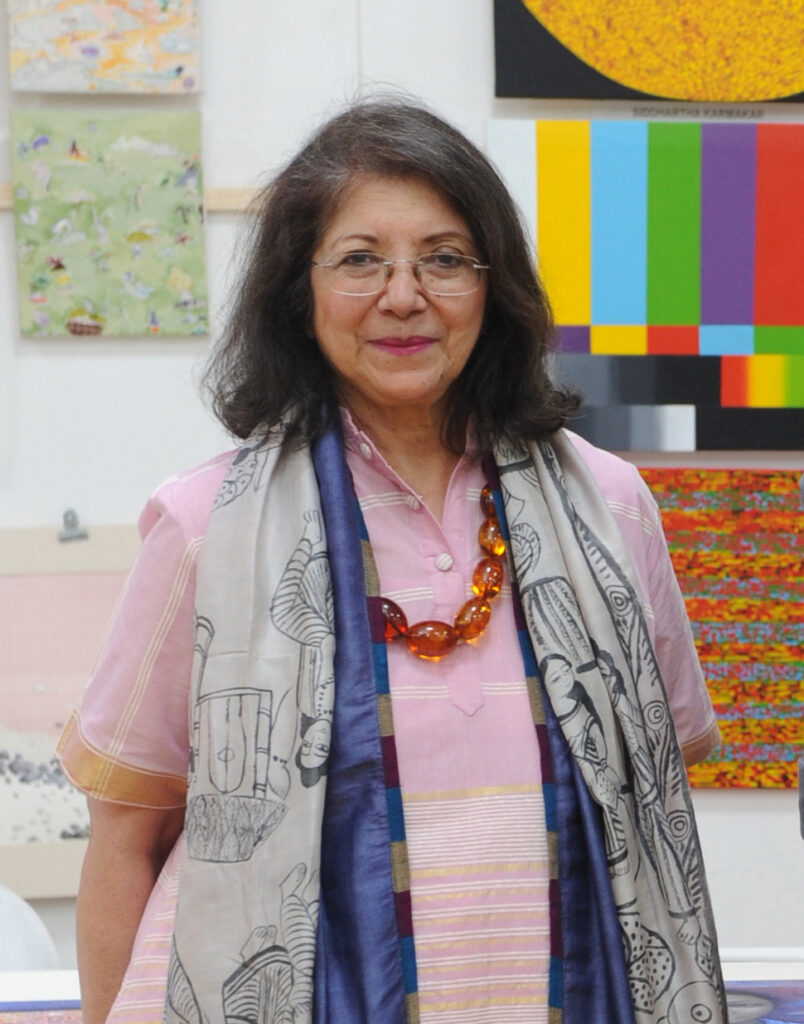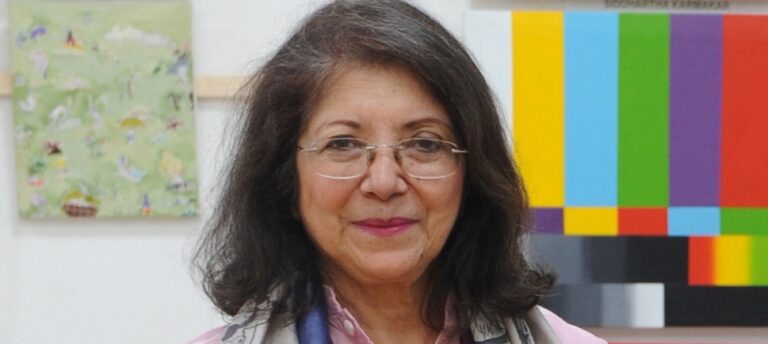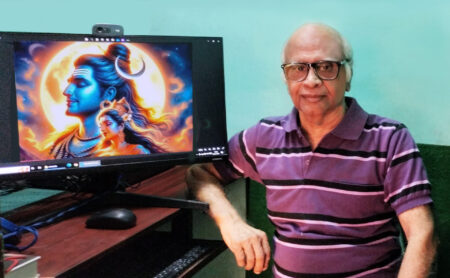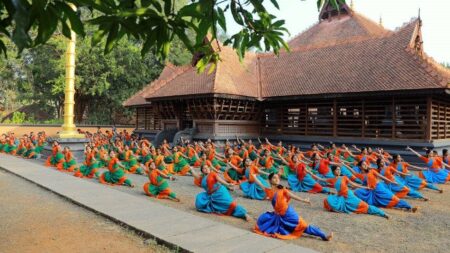Eminent art curator and promoter of the Centre of International Modern Art (CIMA), a prominent art gallery in Kolkata, Rakhi Sarkar speaks to IAR’s Jinoy Jose P. on her curatorial journey and the latest trends in the world of art and culture. Excerpts:
You’ve curated and organized more than 200 art shows across India, the UK, Singapore and Canada. How did your art journey begin?
I have always been a lover of art. I come from a family of artists. My aunt was a student of Nandalal Bose. She was one of the women who painted the Constitution of India.
But I studied Science as well as Liberal Arts. After we got married, my husband (Aveek Sarkar) and I started collecting artwork. We not only saw art worldwide but also read a lot about it and communicated with a lot of artists, even internationally. It was a love affair.
It all culminated in 1986 when I was the president of the Ladies Study Group, the women’s wing of the Indian Chamber of Commerce, the oldest body of commerce in India. I was representing that as the President and one of my projects was an art exhibition called ‘Visions’. It documented four artists – Bikash Bhattacharjee, Somnath Hore, Ganesh Pyne and Jogen Chowdhury.
In those days, Bikash Bhattacharya was well known, but the others were known more only in the artistic circle. So, it was like four retrospectives thrown into one and this was done in collaboration with the Birla Academy of Art and Culture in Kolkata. We flew in artworks from across India, including those from the National Gallery of Modern Art, from Karan Singh’s private collection, and so on. There were almost 200 artworks. It was a phenomenal success because nothing of that scale had ever been done in Calcutta. That was my inception into first-hand curatorial work.
And then?
Until then, I didn’t have much to do with artists, except being an avid collector and reading a lot on art and culture. There was no major institutional involvement. But after the 1986 exhibition, several artists approached me to start an art centre. We didn’t have any good art galleries in Calcutta then. Bombay (Mumbai) had some and Delhi, a few, but not in Calcutta. So, they asked me, ‘Why don’t you start an art gallery where you can not only promote art but bring out publications on art?’. ‘Visions’ had published a flashy catalogue, which was a first in India then.
Soon, my husband told me, ‘We have got some space and why don’t you think of doing something?’ However, I didn’t want to get into it because I was involved in a lot of social projects. Also, I wanted to learn more about art first. In fact, I had thought of running a small art centre, but not in the commercial sense.
In the process, all my friends in America, Europe, and in government agencies helped me meet a few of the top museum personalities. And they all gave a lot of time, effort and interest. That first introduced me to the world of art.
We were in New York and it was our friend Harry (Harold) Evans, the famous editor of Sunday Times, who had by then moved to New York and was heading Random House, who introduced me to Marc Glimcher, who was the owner of Pace Gallery, which was the biggest and the most successful private gallery in the world. By then, we had the space and the architectural planning had been done, but it wasn’t open yet. Marc introduced me to a lot of things, especially formatting. He wasn’t in favour of calling it a ‘Centre’ as he felt it had a nonprofit ring to it. But I wanted the space to have a non-commercial aspect as well. Pace helped us immensely, helping us integrate international practices into our venture. That’s how CIMA was started.
Interesting!
In 1992, after the Babri Masjid demolition, we organised an event called ‘Wounds’, where several artists came together and expressed their concerns around what was happening in the country. ‘Wounds’ was named after Somnath Hore’s body of works. The exhibition was funded by Tata Steel and it opened in Kolkata and travelled to the NGMA in Delhi. It was meant to go to the National Centre for the Performing Arts (NCPA), Mumbai, but unfortunately, the 1993 Mumbai blasts and we had to cancel the event.
Although ‘Wonders’ was the first exhibition, it was not CIMA’s inaugural exhibition. In November 1993, we hosted the inaugural exhibition titled ‘Trends and Images’. When I started CIMA, I began with major, established artists.
In 1996, we took our 200-piece artwork show to London and we had to take permission from the Reserve Bank of India for the big event. In those days, the economy had not ‘opened up’. So, we had to repatriate the amount of money spent. The spending was almost close to Rs 1 crore in those days, so I had to repatriate the amount through the sale of arts. It was tough, but the exhibition was a huge success in London.
Sotheby’s and Christie’s among others said that this was the kind of thing that they were hoping for. The Indian government, over the years, have hosted a lot of exhibitions during Indira Gandhi’s time, even during Rajiv Gandhi’s time, but subsequently, everything stopped.
Our London exhibition ‘Chamatkara’ was a big event done with all the flash and grandeur. We rented out space in a heritage building, and we showed 200 works of art, which also included works of some of the award-winning ethnic artists. The show ended with cinema posters by Satyajit Ray. I haven’t been able to replicate an exhibition of that scale in India as yet. Nearly 2,500 people came just for our opening. That was a mammoth exercise.
In 1997, we were invited by the Singapore government to curate an exhibition called ‘Tryst with Destiny: Art from Modern India’ to commemorate 50 years of Indian Independence. So, these two large exhibitions put CIMA on the world map and put Indian art in a big way on that map.
Since then, we have been documenting historical shows. We documented the whole of art from the Bengal region and our exhibitions travelled to the National Gallery Mumbai to the Prince of Wales Museum (now known as Chhatrapati Shivaji Maharaj Vastu Sangrahalaya) to the National Gallery in Delhi and so on.
Tell us about the challenges involved in building such missions and how have the challenges changed over time?
When we started in the 1990s, there was very little infrastructure and a backup system, even freighting art was unknown in India. Only Laxmi Prasad Sihare knew the system well and had set up an excellent infrastructure in the National Gallery of Modern Art (NGMA) in those times. He shared the technical know-how as he had also trained a group of people who used to travel worldwide with the exhibitions hosted by the government.
The same group trained my staff. There was no proper ecosystem in place. For instance, if I had to carry artwork from Kolkata to Delhi or Mumbai, we had to have our own freight system – I had to pack, hire a truck and organise somebody to work on the crating and carry the load. There were no agencies such as FedEx or Bluedart then to do this work.
Then, there was the catalogue publishing work. ‘Visions’ was the first exhibition that came with a major catalogue. I doubt if there were any other major catalogues published before that. Yes, things were difficult when we started, it was a struggle. Things have become much more professional now.
How did Covid-19 influence or impact your work, and art in general?
With Covid-19, I am finding that art has become more contemplative. We are now hosting the fourth edition of the CIMA Awards. We have almost a 20-member jury in this edition, a preliminary jury to shortlist and the final jury that gives us the award. All of them unanimously agreed that works in this particular edition, especially done during the pandemic period, look a lot more profound and mature. So yes, challenges do help art.
Money has not been terribly good for Indian art, to be honest. Money in Europe and America has helped art. But in India, money has depleted quality. With money, somehow quality was compromised because the kind of money that came in was not there to support the best of art. It was there for decorative purposes, for grandeur and prestige, for the wrong reasons… So, I don’t think money is an issue. The best art happens when there’s the least money, at least in our country.
The challenges of Covid-19 have rendered not only time to the artists but also helped them introspect for the first time in many years.

There is still a perception that the art market is rather elitist and not very democratic or egalitarian.
As an institution, we have been systematically supporting a programme since 2008. We introduced a programme called ‘The Art Mela’. We introduced quality and to achieve that we sat with all the artists. We figured that art was going into expensive drawing rooms and boardrooms and getting lost. It was being collected for the wrong reasons – for investment purposes, or the prestige of it but not for the love of art always. We were concerned about this trend. And that’s why we started the Art Mela. This programme has grown to be popular as it has brought in several young artists and their collection to the fore.
Whoever we feature in the Art Mela is either a CIMA award finalist or a national award winner or a state award winner. If a buyer is spending even Rs 5,000 on your artwork, it should be worth it. The buyer should know that the quality is unquestionable.
Art Mela has been a phenomenal success and has taken art to young collectors. For instance, an IT professional who makes a good lakh or two a month tends to have a lot of disposable income. So, he buys art instead of investing in cars or jewellery. There is a whole big community in Bombay, Delhi and Calcutta who invest in art. We focused on developing a young collectorship and, at the same time, we encouraged them to visit exhibitions by sending out catalogues and educating them in art.
In the last 30 years, CIMA has developed an informed clientele.
The world of art sees several new trends now, thanks to social media and digital technology.
The digital medium has made art a lot more democratic. All that happens on social media such as promoting the artists, exchanging information on art is not detrimental at all. But yes, there’s a lot of danger of the fake art market, which has gone up over the years. We observe a lot and take care and safeguard our images.
At the same time, the digital world allows the youngsters sitting in any remote village in the country to view what is going on in New York or Paris or London. So, it’s a fantastic world, but one has to also take necessary precautions.
What’s your take on trends like NFT in art?
These are trends that will come and go. Technology-oriented art and technology-oriented business practices in the art will always be based on trends. There will be a lot of harm done in the process and a lot of great services also is being done. We have to see how it impacts art.
Have you tried painting?
I learned painting as my aunt suggested. She said since I was interested in art and since Aveek (Sarkar) and I collect art, she recommended I should learn the art from her friend Kamala Roy Chowdhury, who was the founding member of the contemporary artists’ society and among the first pack of women who travelled from Bengal to study in France. She started the art studio and I joined her studio for 3-4 years. At that stage, CIMA was not on the horizon, but today I feel that has helped me because I learned the fundamentals of art and art movements, especially the French mode of painting and drawing among other things. So, you can’t fool me or you can’t fool my eyes. But I am not a practising artist.
Write to us at [email protected]




